Electro-Assisted 3D Printing Multi-Layer PVDF/CaCl2 Composite Films and Sensors
Abstract
:1. Introduction
2. Materials and Methods
3. Results
3.1. Microstructure Analysis of PVDF/CaCl2 Composite Film
3.2. Electrical Properties of PVDF/CaCl2 Composite Films
3.3. Performance of PVDF/CaCl2 Composite Film Sensor with Single-Layer Structure
3.4. Performance Analysis of Multi-Layer PVDF/CaCl2 Composite Film Sensor
4. Conclusions
Author Contributions
Funding
Institutional Review Board Statement
Informed Consent Statement
Data Availability Statement
Acknowledgments
Conflicts of Interest
References
- Ribeiro, C.; Costa, C.M.; Correia, D.M.; Nunes-Pereira, J.; Oliveira, J.; Martins, P.; Gonçalves, R.; Cardoso, V.F.; Lanceros-Méndez, S. Electroactive poly(vinylidene fluoride)-based structures for advanced applications. Nat. Protoc. 2018, 13, 681–704. [Google Scholar] [CrossRef] [PubMed]
- Ramachandran, K.; Miscioscia, R.; De Filippo, G.; Pandolfi, G.; Di Luccio, T.; Kornfield, J.A. Tube Expansion Deformation Enables In Situ Synchrotron X-ray Scattering Measurements during Extensional Flow-Induced Crystallization of Poly l-Lactide Near the Glass Transition. Polymers 2018, 10, 288. [Google Scholar] [CrossRef] [PubMed] [Green Version]
- Wang, A.D.; Chen, C.F.; Zhu, Y.; Liao, L.C.; Qian, J.L.; Yuan, F.G.; Zhang, N.Y. Enhanced β-Phase in Direct Ink Writing PVDF Thin Films by Intercalation of Graphene. J. Inorg. Organomet. Polym. 2020, 30, 1497–1502. [Google Scholar] [CrossRef]
- Chen, C.; Cai, F.; Zhu, Y.; Liao, L.; Qian, J.; Yuan, F.-G.; Zhang, N. 3D printing of electroactive PVDF thin films with high β-phase content. Smart Mater. Struct. 2019, 28, 065017. [Google Scholar] [CrossRef]
- Chen, C.F.; Zhang, R.F.; Zhu, J.G.; Qian, X.Y.; Zhu, J.; Ye, X.; Zhang, M.Y. Direct writing polyvinylidene difluoride thin films by intercalation of nano-ZnO. Polym. Eng. Sci. 2021, 61, 1802–1809. [Google Scholar] [CrossRef]
- Sharafkhani, S.; Kokabi, M. Tailoring favor crystalline structure via electrospun PVDF/BaTiO3 nanofibers. In AIP Conference Proceedings; AIP Publishing LLC: College Park, MD, USA, 2018; Volume 1920, p. 020001. [Google Scholar] [CrossRef]
- Selvan, R.T.; Jayathilaka, W.A.D.M.; Chinappan, A.; Alam, H.; Ramakrishna, S. Modelling and Analysis of Elliptical Cantilever Device Using Flexure Method and Fabrication of Electrospun PVDF/BaTiO3 Nanocomposites. Nano 2020, 15, 2050007. [Google Scholar] [CrossRef]
- Karanth, P.N.; Desai, V.; Kulkarni, S.M. Modeling of single and multilayer polyvinylidene fluoride film for micro pump actuation. Microsyst. Technol. 2009, 16, 641–646. [Google Scholar] [CrossRef]
- Lee, H.Y.; Choi, B. A multilayer PVDF composite cantilever in the Helmholtz resonator for energy harvesting from sound pressure. Smart Mater. Struct. 2013, 22, 115025. [Google Scholar] [CrossRef]
- Zhao, J.; You, Z. A Shoe-Embedded Piezoelectric Energy Harvester for Wearable Sensors. Sensors 2014, 14, 12497–12510. [Google Scholar] [CrossRef]
- Spanu, A.; Pinna, L.; Viola, F.; Seminara, L.; Valle, M.; Bonfiglio, A.; Cosseddu, P. A high-sensitivity tactile sensor based on piezoelectric polymer PVDF coupled to an ultra-low voltage organic transistor. Org. Electron. 2016, 36, 57–60. [Google Scholar] [CrossRef]
- Musazzi, U.M.; Selmin, F.; Ortenzi, M.A.; Mohammed, G.K.; Franz’e, S.; Minghetti, P.; Cilurzo, F. Personalized orodispersible films by hot melt ram extrusion 3D printing. Int. J. Pharm. 2018, 551, 52. [Google Scholar] [CrossRef] [PubMed]
- Macedo, P.B.; Moynihan, C.T.; Bose, R. Glasses. Phys. Chem. 1972, 13, 171. [Google Scholar]
- Garain, S.; Sen, S.; Henkel, K.; Schmeißer, D.; Mandal, D. Enhancement of Electroactive β-phase and Superior Dielectric Properties in Cerium Based Poly(vinylidene fluoride) Composite Films. Mater. Today Proc. 2018, 5, 10084–10090. [Google Scholar] [CrossRef]
- Martins, P.; Lopes, A.C.; Lanceros-Mendez, S. Electroactive phases of poly(vinylidene fluoride): Determination, processing and applications. Prog. Polym. Sci. 2014, 39, 683–706. [Google Scholar] [CrossRef]
- Patro, T.U.; Mhalgi, M.V.; Khakhar, D.V.; Misra, A. Studies on poly(vinylidene fluoride)–clay nanocomposites: Effect of different clay modifiers. Polymer 2008, 49, 3486–3499. [Google Scholar] [CrossRef]
- Lewis, J.A. Direct Ink Writing of 3D Functional Materials. Adv. Funct. Mater. 2006, 16, 2193–2204. [Google Scholar] [CrossRef]
- Ramos, M.; Correia, H.M.; Lanceros-Mendez, S. Atomistic modelling of processes involved in poling of PVDF. Comput. Mater. Sci. 2005, 33, 230–236. [Google Scholar] [CrossRef] [Green Version]
- Ma, W.; Zhou, B.; Liu, T.; Zhang, J.; Wang, X. The supramolecular organization of PVDF lamellae formed in diphenyl ketone dilutions via thermally induced phase separation. Colloid Polym. Sci. 2012, 291, 981–992. [Google Scholar] [CrossRef]
- Peng, Y.; Wu, P.Y. A two dimensional infrared correlation spectroscopic study on the structure changes of PVDF during the melting process. Polymer 2004, 45, 5295–5299. [Google Scholar] [CrossRef]
- Montina, T.; Wormald, P.; Hazendonk, P. 13C Solid-State NMR of the Mobile Phase of Poly(vinylidene fluoride). Macromolecules 2012, 45, 6002–6007. [Google Scholar] [CrossRef]
- Ince-Gunduz, B.S.; Alpern, R.; Amare, D.; Crawford, J.; Dolan, B.; Jones, S.; Kobylarz, R.; Reveley, M.; Cebe, P. Impact of nanosilicates on poly(vinylidene fluoride) crystal polymorphism: Part Melt-crystallization at high supercooling. Polymer 2010, 51, 1485–1493. [Google Scholar] [CrossRef]
- Wang, A.D.; Chen, C.F.; Qian, J.L.; Yang, F.; Wang, L.; Zhang, M.Y. Enhanced Electrical Properties of PVDF Thin Film by Addition of NaCl by Near-Electric-Field 3D Printing. J. Electron. Mater. 2021, 50, 4781–4786. [Google Scholar] [CrossRef]
- Kuo, W.-K.; Shieh, M.-Y.; Yu, H.-H. Three-dimensional infrared absorption of hot-drawn and poled electro-optic PVDF films. Mater. Chem. Phys. 2011, 129, 130–133. [Google Scholar] [CrossRef]
- Liao, L.C.; Chen, C.F.; Qian, J.L.; Zhang, Y.M.; Zhang, R.F.; Zhu, J.G. Direct writing of PVDF piezoelectric film based on near electric field added by [Emim]BF4. Mater. Res. Express 2020, 7, 016437. [Google Scholar] [CrossRef]
- Wang, A.; Shao, M.; Yang, F.; Shao, C.; Chen, C. Preparation and properties of antibacterial PVDF composite thin films. Eur. Polym. J. 2021, 160, 110803. [Google Scholar] [CrossRef]
- Chen, C.; Zhu, J.; Zhang, Y.; Wang, A. Preparation and Luminescence Properties of PVDF/ZnS: Mn Flexible Thin-Film Sensors. Coatings 2022, 12, 449. [Google Scholar] [CrossRef]
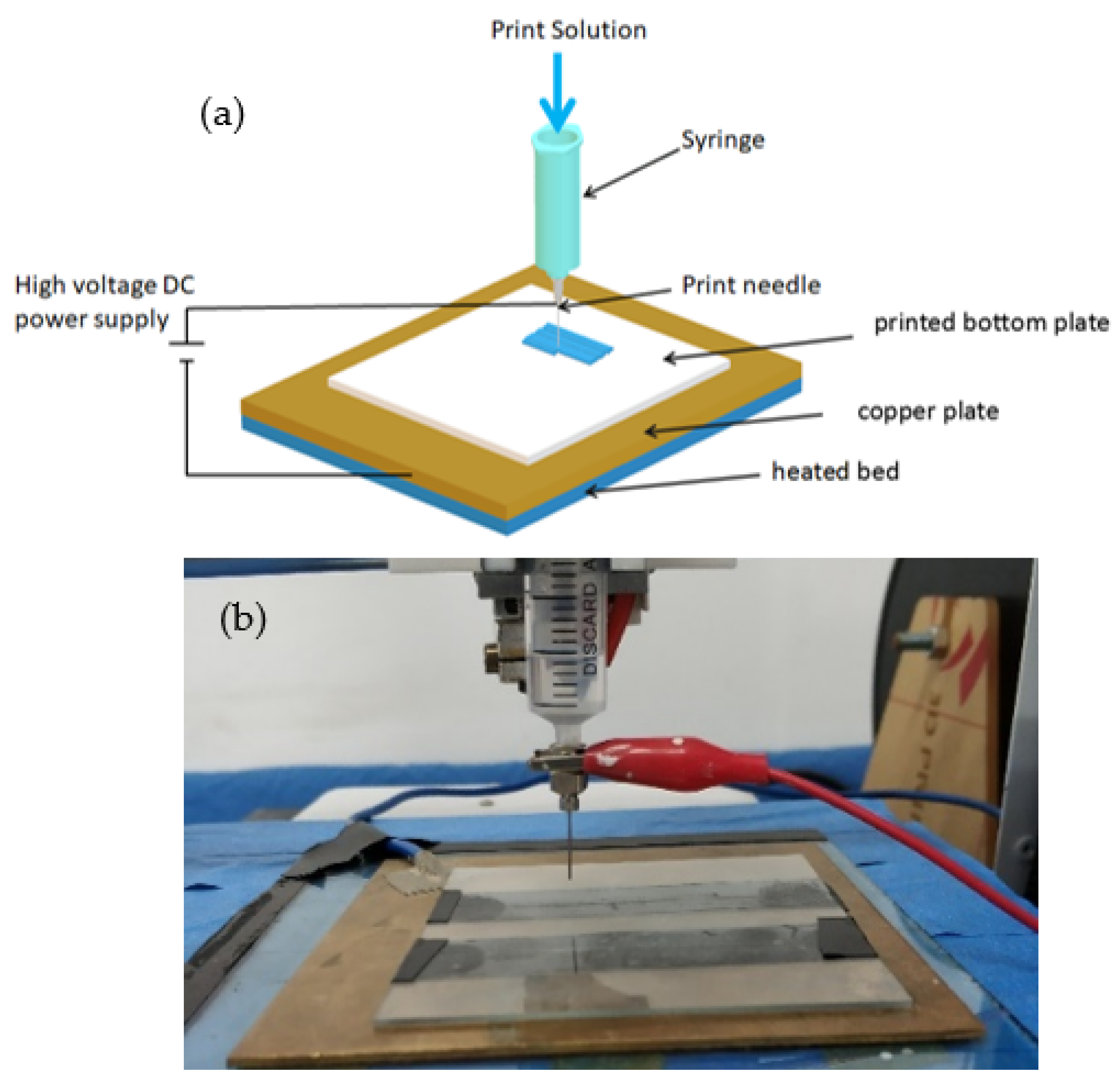

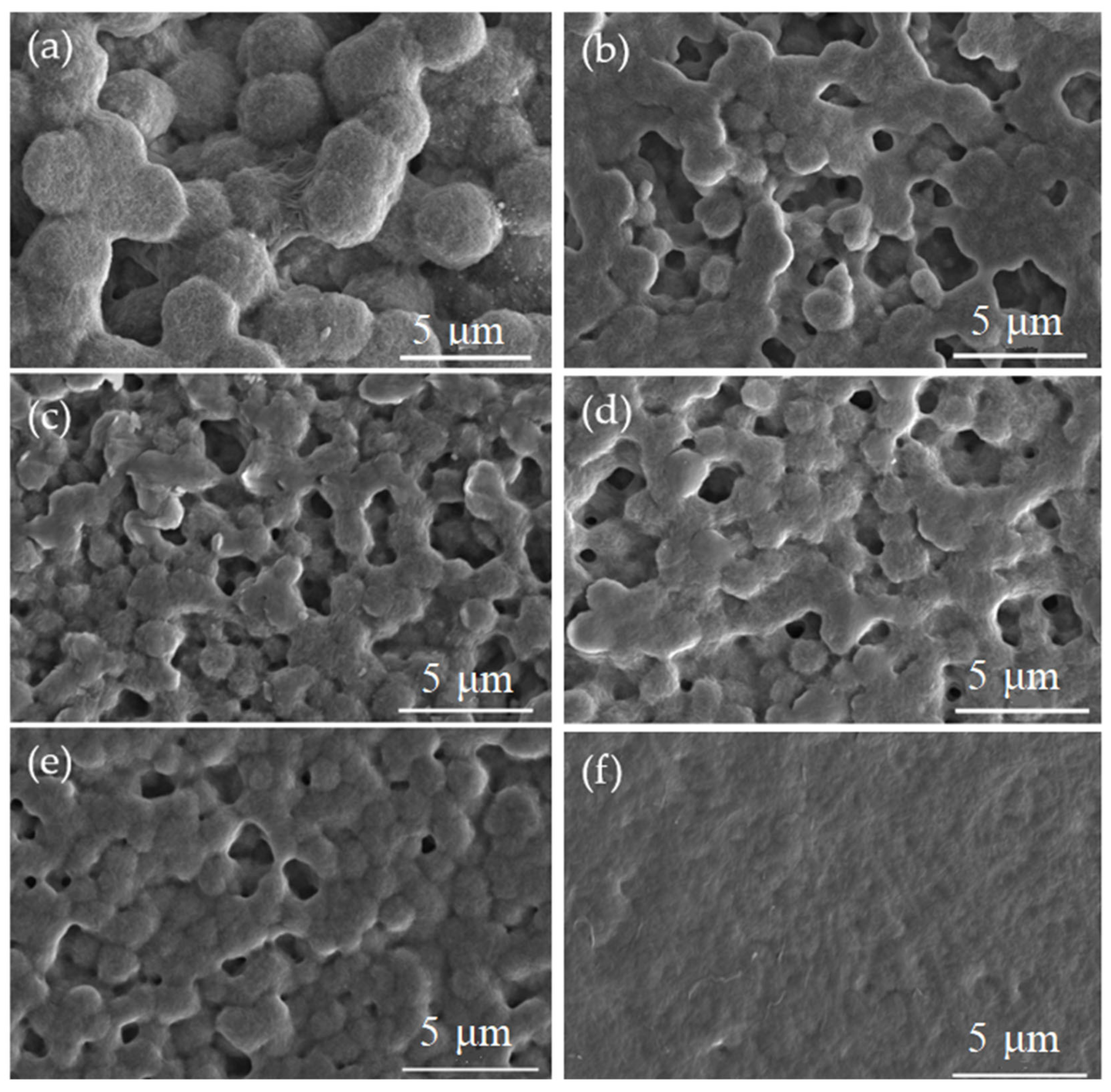
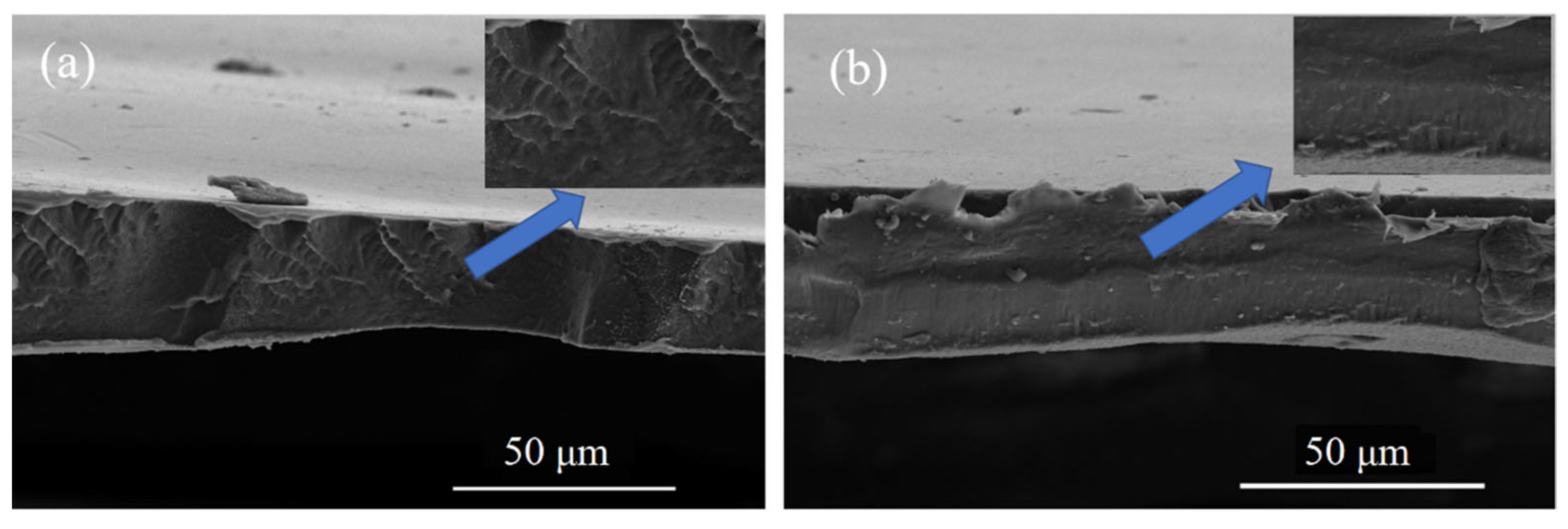


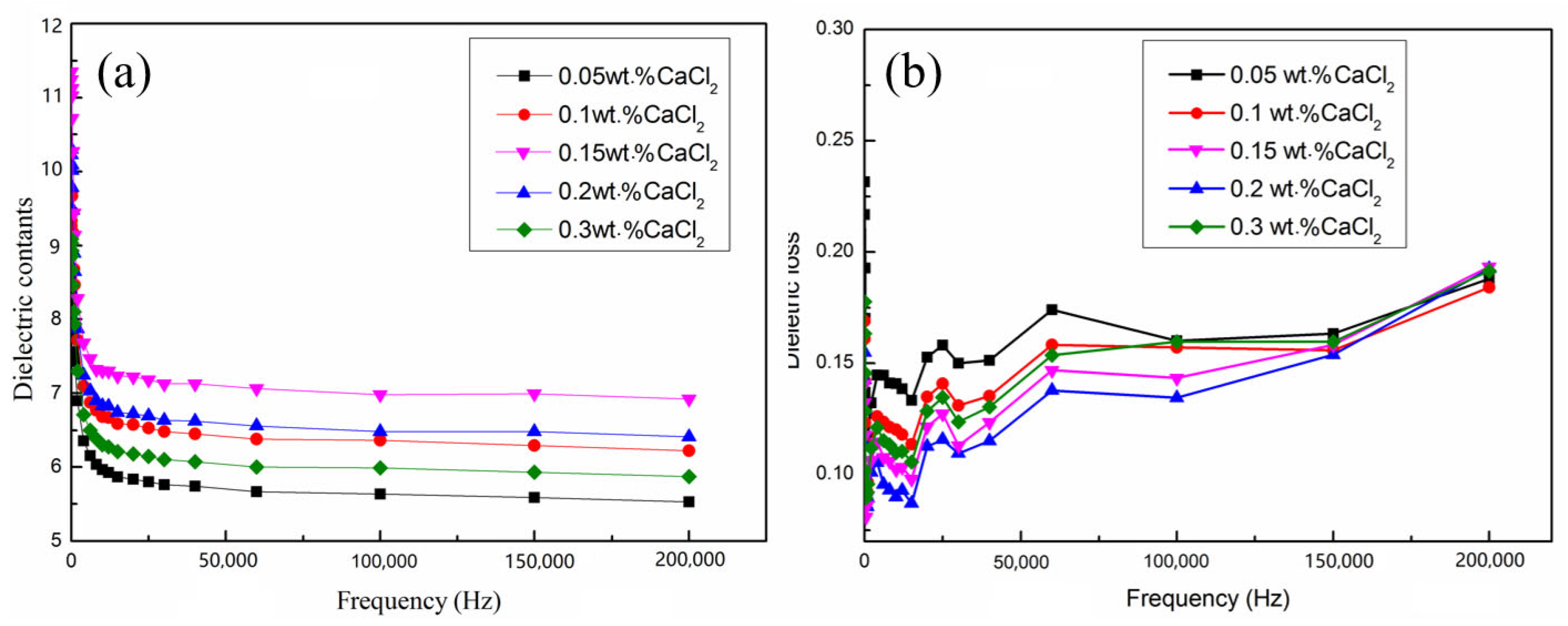
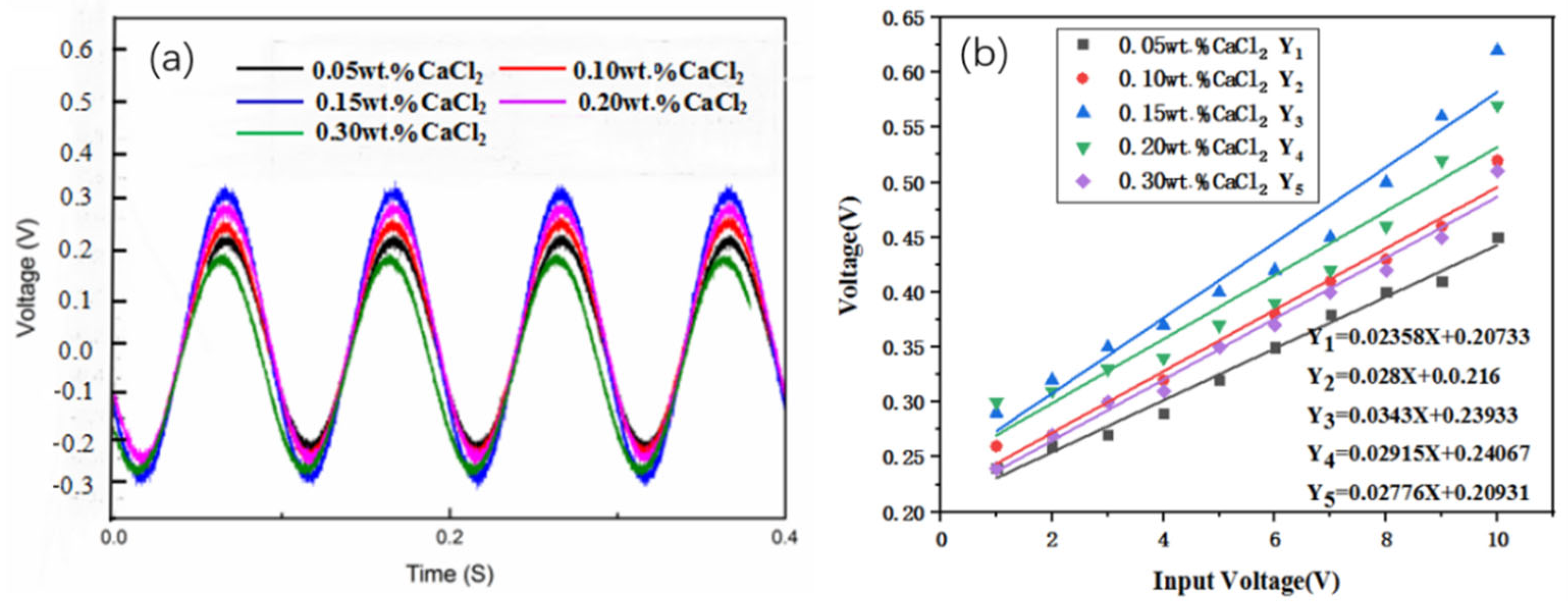
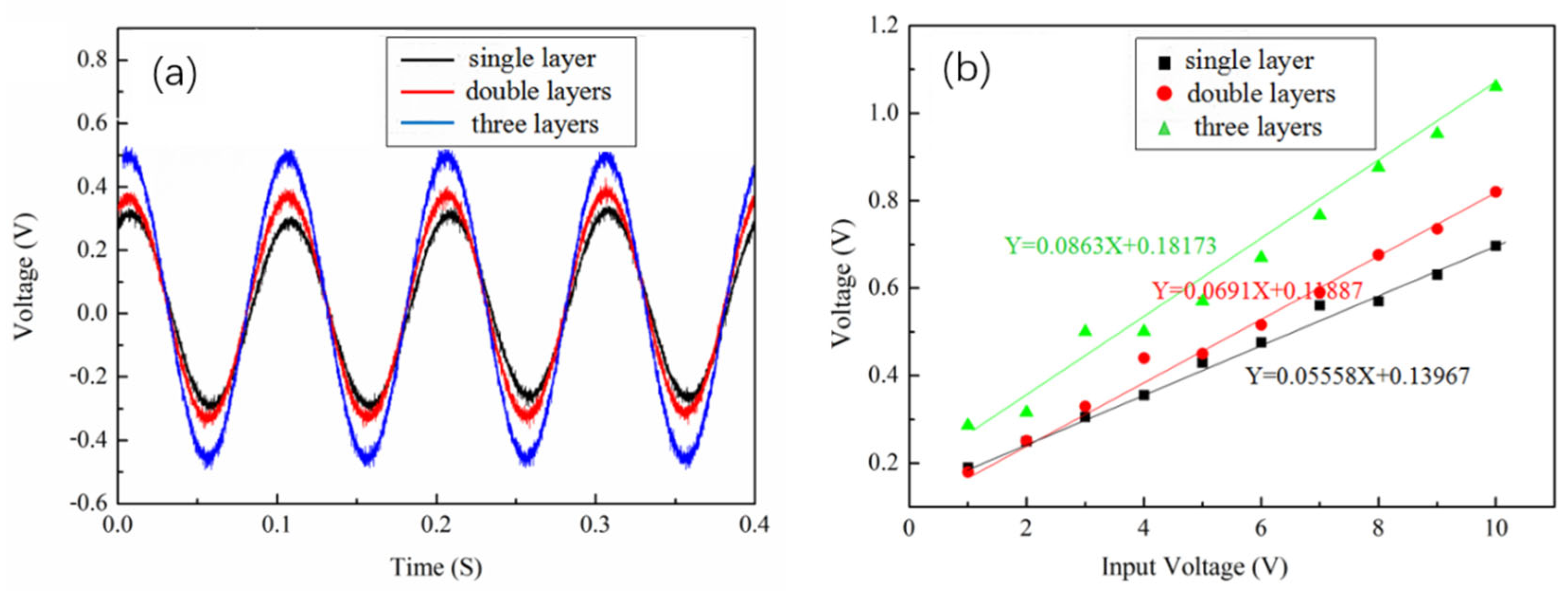
| Films with CaCl2 | Total Crystallinity (%) | F(β) (%) | β-phase Content (%) |
|---|---|---|---|
| 0 | 46.67 | 78.10 | 36.45 |
| 0.05 | 55.78 | 81.84 | 45.65 |
| 0.10 | 57.31 | 82.17 | 47.09 |
| 0.15 | 58.63 | 82.67 | 48.47 |
| 0.20 | 58.03 | 82.56 | 47.91 |
| 0.30 | 56.11 | 82.53 | 46.30 |
| Films with CaCl2 | 0.05 wt.% | 0.1 wt.% | 0.15 wt.% | 0.20 wt.% | 0.30 wt.% |
| K | 0.02359 | 0.02800 | 0.03430 | 0.02915 | 0.02776 |
Publisher’s Note: MDPI stays neutral with regard to jurisdictional claims in published maps and institutional affiliations. |
© 2022 by the authors. Licensee MDPI, Basel, Switzerland. This article is an open access article distributed under the terms and conditions of the Creative Commons Attribution (CC BY) license (https://creativecommons.org/licenses/by/4.0/).
Share and Cite
Wang, A.; Liu, J.; Shao, C.; Zhang, Y.; Chen, C. Electro-Assisted 3D Printing Multi-Layer PVDF/CaCl2 Composite Films and Sensors. Coatings 2022, 12, 820. https://doi.org/10.3390/coatings12060820
Wang A, Liu J, Shao C, Zhang Y, Chen C. Electro-Assisted 3D Printing Multi-Layer PVDF/CaCl2 Composite Films and Sensors. Coatings. 2022; 12(6):820. https://doi.org/10.3390/coatings12060820
Chicago/Turabian StyleWang, Andong, Jianhua Liu, Chenkang Shao, Youming Zhang, and Caifeng Chen. 2022. "Electro-Assisted 3D Printing Multi-Layer PVDF/CaCl2 Composite Films and Sensors" Coatings 12, no. 6: 820. https://doi.org/10.3390/coatings12060820
APA StyleWang, A., Liu, J., Shao, C., Zhang, Y., & Chen, C. (2022). Electro-Assisted 3D Printing Multi-Layer PVDF/CaCl2 Composite Films and Sensors. Coatings, 12(6), 820. https://doi.org/10.3390/coatings12060820









